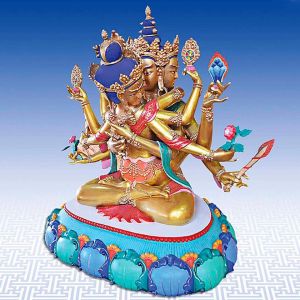The Essence of Pure Land Buddhism
What is Pure Land Buddhism?
The Essence of Pure Land Buddhism
In the world there are many ideologies, systems of thought, and creeds by which we attempt to lead a better life or to realize an ideal society. Buddhism offers an excellent way for everyone to realize the ultimate goal of human existence in terms of "attaining enlightenment" through the profound awareness of truth. According to Shakyamuni Buddha, final peace in the world as well as in the individual will be realized when the individual becomes liberated from ignorance and self-attachment, which are the causes of our suffering. Beyond the horizon of the finite, self-limited world, we can find the infinite world of great peace and happiness. When we learn and practice the teachings of the Buddha as presented in the scriptures, we will be able to attain this final state.
In the teachings of the Buddha, we can find many ways of realizing this final state. They may be classified into the two major streams: the Mahayana and the Theravada, the Esoteric and the Exoteric, the Easy Path and the Difficult Path, or Other-power and Self-power, respectively. According to the Pure Land tradition, the entire teaching of the Buddha can be divided into the twofold path of the Holy Way (shodomon) and the Pure Land (jodomon). The Holy Way is the way to attain enlightenment after eliminating ignorance and self-attachment by one's own effort. This may be called the way of wisdom, for it is the way to accomplish enlightenment by the power of wisdom attained through self-discipline. It is vitally important for a Buddhist to follow the teachings of the Buddha in order to achieve religious peace of mind. However, when observing our existential being seriously in the light of the way of wisdom, we often come to realize how much we are unable to fulfill the required disciplines to eliminate ignorance and self-attachment. The more we seriously reflect upon ourselves, the more we may find ourselves "unliberated" by the way of wisdom.
When we lose the way to enlightenment by the Holy Way, we often sink down into a world of darkness and despair. Amida Buddha, however, provides a way for us to attain salvation from this hopeless state. This is the way illuminated by the light of the grace of Amida Buddha, the Path to the Pure Land. The Pure Land school opens the channel to attain salvation for those unliberated through the way of wisdom. However, since this school is different from the Holy Path, it is sometimes referred to as pseudo-Buddhism. It seems to be Buddhism, but it is not considered to be genuine from the traditional point of view. Pure Land Buddhism is also mistakenly regarded as a religion for lazy people. It is sometimes called the Easy Path as it requires only the simple act of faith and recitation of the nembutsu as its primary religious disciplines rather than the many practices of observing precepts, attaining the state of "emptiness," chanting the various sutras and so forth, as the means of reaching enlightenment.
The Pure Land school established on this basis may be called the way of salvation by a "power outside of ourselves," or "other power" (i.e., the power of Amida Buddha). Buddhism is the teaching of the Buddha and the teaching by which to become a buddha, that is, Buddhism is the way through which everyone, regardless of age, sex, race, or ability can be liberated and attain enlightenment. Therefore, if anyone of disability were excluded it could not be considered Buddhism in its true sense. In other words, Buddhism cannot reveal its truth if anyone is eliminated. When Buddhism is understood as the way of universal salvation, we can understand the profound meaning of the Pure Land school. The essence of Pure Land Buddhism is revealed and apprehended through this line of reasoning and belief.
Source
[[1]]
